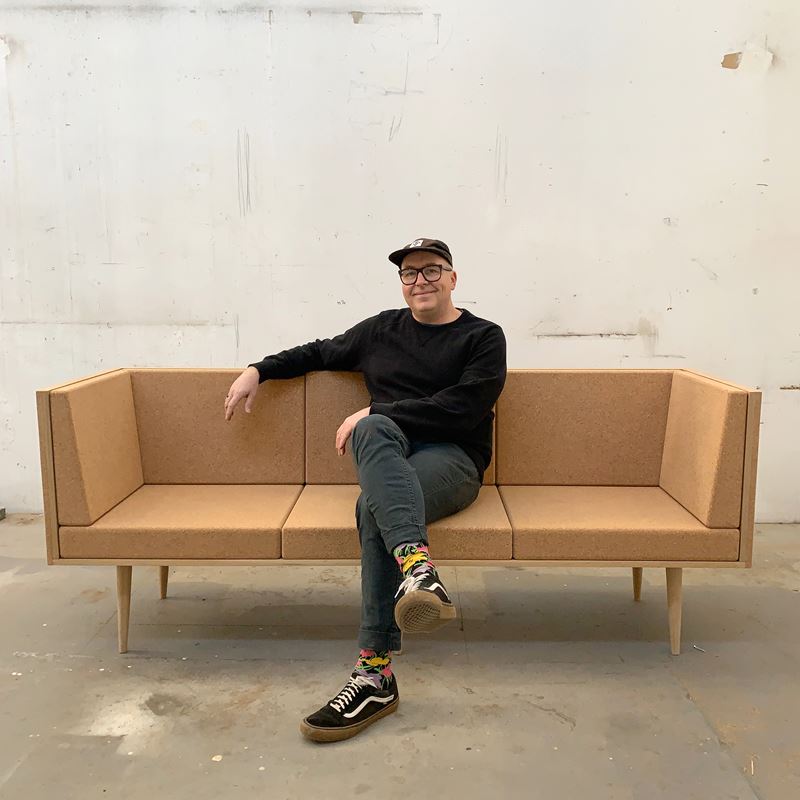It is in bustling New York that the first Google Store comes to life. In contrast to the city’s frenetic pace and the concrete colors, cork was the material chosen for development of the store’s items of furniture, bringing a sense of calm to the Great Apple and fostering a perfect symbiosis between Nature and Technology.
We spoke with Daniel Michalik, the designer responsible for creating the items of furniture, who affirmed that “cork was a natural choice”, due to both its sustainability credentials and warm visuals.
-
Daniel Michalik
"Cork was a natural choice, since it is so sustainable it helped to achive the LEED Platinum status".
© Google and Paul Warchol
How did this project come about and why did you choose cork for the first Google Store?
I should first note that the Store was designed by Reddymade, a New York Architecture office founded by Suchi Reddy. I was working directly for them, although Google was of course the end client. There were three main reasons why Google was interested in choosing cork as a theme for their retail environment. First, their objective for this space was to be among the few to achieve LEED Platinum status. That made cork a natural choice, since it is so sustainable. Second, they wanted a material that had a friendly, humanistic character to it. This is one of the qualities that has always attracted me to cork. Third, cork was used in the Store’s "contextual zone", meaning that the goal was to build a "simulation" of an actual home environment, so customers could imagine the home products in their own environment. Cork has a "blank slate" quality to it, in that visitors can project their own ideas or experiences on to the material.
Which items of furniture were developed for the Store?
We developed full scale, functional furniture in combinations of cork and American White Oak for the space. These included furniture for a living space, including a sofa, lounge chair, large round ottoman, coffee table, bookcase, side tables, etc. We also designed objects for a children's space, including a bed, rug, shelving, desk and chair. Finally, we designed elements for a "kitchen" space, including a counter with a cork sink, a bar, bar stools, etc. Everything was designed and built in our studio in Brooklyn, New York.
Why did you suggest using cork?
I advocated for the using of cork, because it is one of the healthiest materials on the planet. Cork is a healthy material, from the perspective of the natural system’s health / renewability, from the perspective of human labor and paying fair wages to all those involved in the supply chain, and from the perspective of the health of those that use objects made from cork.
© Google and Paul Warchol.
What do you like the most about this raw material?
I love the fact that when one works with cork, whether you are a farmer, harvester, producer or designer, one must take the entire ecosystem into account. Since cork is responsibly harvested, the material is not just extracted. It is extracted from the tree, but the tree grows stronger and healthier. When the tree grows stronger, the ecosystem and the biodiversity that relies on the tree grows stronger. Traditional human wisdom and skill is respected, so the culture grows stronger. Cork is a model that humans must learn from as we enter the climate crisis, and have to redefine our relationship to materials.
When did you start using cork in your projects?
I have been designing cork furniture and objects since 2005. In this year, I completed my Master's degree in Furniture Design at The Rhode Island School of Design. My Master's thesis was all about new uses of cork in furniture. In the following year, I exhibited my thesis project at the Salone del Mobile in Milan, and from there my cork practice was born.
What was it like to work with Amorim Cork Composites?
ACC has been a partner in my cork design projects for many years. First, ACC is committed to innovation, and is forward-looking in seeing the new potential for cork applications in design and architecture. ACC was able to custom produce many of the materials and components for this project. Second, ACC and Amorim are world leaders in cork, and are at the forefront of the sustainability and human concerns in the industry. ACC has deep respect for the culture, history and embedded wisdom of cork agriculture and industry.
Cork, a perfect symbiosis between Nature and Technology in the first Google Store
Would you like to know more about this subject?
Let us know your details and we'll get back to you.
